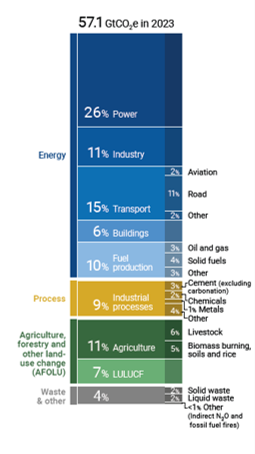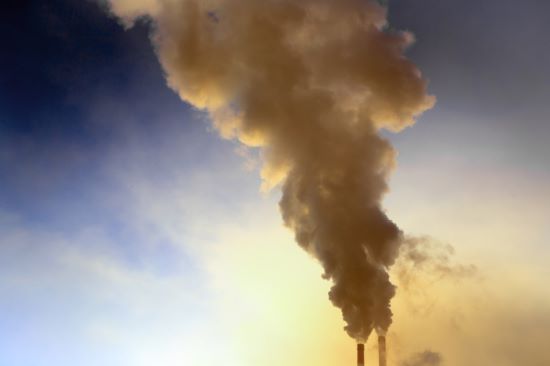Last week the United Nations Environment Programme published its Emissions Gap Report 2024.
In its Executive Summary, it states:
“Unless global emissions in 2030 are brought below the levels implied by existing policies and current nationally determined contributions (NDCs), it will become impossible to reach a pathway that would limit global warming to 1.5 Celsius with no or limited overshoot (>50% chance), and strongly increase the challenge of limiting warming to 2°C (>66% chance). The next NDCs must deliver a quantum leap in ambition…with accelerated mitigation action in this decade.”
It further adds “The magnitude of the challenge is indisputable.”
Just when we think COP meetings could make a difference, the UN report tells us that they are not and that global greenhouse gas emissions (GHGs) are still climbing.
The rise between 2022 and 2023 was 1.3%, setting a new record of 57.1 Gigatons (57.1 billion tons of emitted GHGs from human activity per year). That rise has been faster than the average of 0.8% growth from 2010 to 2019, the pre-COVID-19 pandemic era.
The biggest contributor to the rise in GHGs has been the electrical power sector at 26%, with transportation second at 15% (see infographic below).

Since COP 28 when countries were urged to update target NDCs, the report states that only one country has done so. Several countries’ NDCs have yet to reach peak GHG emission levels. Very few countries are post-peak with reported emission drops. None, based on current policies, appear capable of meeting NDC 2030 and 2035 targets to keep within the upper and lower scenarios agreed to at the 2015 Paris Climate Agreement.
As of June 2024, 107 countries responsible for 82% of global GHGs have made net-zero emission pledges. Some have set net-zero target dates. At current emission levels, however, unless accelerated action occurs, none will achieve their 2030 and 2035 targets.
What is needed follows:
- A 2030 emissions level reduction of 28% to keep atmospheric temperatures rising no more than 2 Celsius (3.6 Fahrenheit), or a 2030 emissions level reduction of 42% to keep atmospheric temperatures rising no more than 1.5 Celsius (2.7 Fahrenheit).
- Starting this year and going to 2035, global GHG emissions need to decline by an average of 4% per year to achieve the 2 Celsius target and 7.5% per year to achieve 1.5 Celsius.
- If action is delayed until 2030, emission reduction targets need to average 8% to limit warming to 2 Celsius and 15% to limit it to 1.5 Celsius.
COP 29 being hosted in the city of Baku in Azerbaijan, ironically a country that is a large GHG oil and gas emissions producer, will ask delegates from member countries to submit new NDCs.
Submitting is aspirational. Committing means acting.
Acting means emission reduction policies at the national and sectorial levels. Whether dealing with advanced economies or developing world countries, it means enacting climate change mitigation and adaptation policies with teeth.
Unfortunately, to date, we see more procrastination than action. The result is an emissions gap that likely will become more difficult to close as we get to 2030 and beyond.
Today, global GHGs continue to rise with the most advanced economies producing 77% of the total. With their current NDC pledges, none of these advanced countries, even if they fulfilled the NDC targets, can stop global atmospheric temperatures from continuing to rise.
That’s why this current UN emissions gap report states that the current global NDC targets established for 2030 will produce a future where temperatures will rise between 2.6 and 2.8 Celsius (4.7 to 5 Fahrenheit) by mid-century and a catastrophic 3.1 Celsius (5.6 Fahrenheit) rise by 2100. In a recent speech, the UN General Secretary called the situation “teetering on a planetary tightrope.”
Is it still possible to stay within the 1.5 Celsius limit?
Yes, but it means building public trust in climate science through a better presentation of the evidence, an explanation of the process of scientific discovery, the telling of the story in plain, jargon-free easy-to-understand language, and engagement in public dialogue that invites input into climate science research.
Doing the above will help to achieve buy-in to do the following on a global level:
- Triple renewable energy from solar, wind, biomass, ocean, geothermal, and hydroelectricity by 2030,
- Scale up energy storage to bridge intermittency from wind and solar renewable energy sources,
- Implement dramatic energy efficiency improvements to our built infrastructure including decentralizing national grids to make them more flexible and adaptable to renewables,
- End fossil fuel subsidies and shift away from the use of these fuels for energy generation, heating and cooling, manufacturing and transportation,
- Expand land and ocean restoration, reforestation, and afforestation to get nature to help us soak up the GHGs,
- And end the procrastination afflicting governments too timid to tackle the threat that many still perceive not to be real or to be far in the future.
Anecdotally, the average person today when asked will note that the climate is changing. Recent extreme weather events for homeowners in Florida, Georgia or Asheville, North Carolina, will have heads nodding in agreement.









